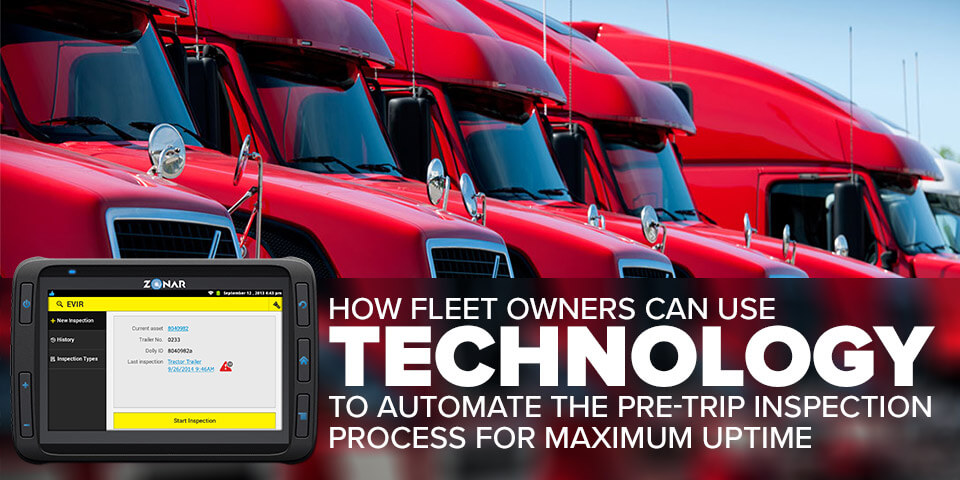
How Fleet Owners Can Use Technology to Automate the Pre-Trip Inspection Process for Maximum Uptime
When a truck in your fleet is down, you're not making money--and neither are your drivers. So, how can you reduce the risk of unplanned downtime?
One key is to ensure your drivers are conducting a thorough pre-trip inspection, where they examine in and around the truck to detect and report potential issues before they can become catastrophic mechanical failures.
(For more information on FMCSA's pre-trip inspection requirements, see https://www.fmcsa.dot.gov/regulations/title49/section/396.11. )
But it's one thing when you're inspecting your own truck; it's entirely another challenge when you have 5, 10, or 15 trucks on the road that you're responsible for. Some of your drivers may be excellent and thorough with their inspections. Others, not so much. So, how do you create a standardized process for pre-trip inspections, where you can ensure they're being done properly by all your drivers, without you having to continually follow up or stay on top of them?
Zonar Systems, a fleet management technology firm headquartered in Seattle, Wash., has developed an Electronic Verified Inspection Reporting (EVIR) system to address this challenge--to automate the inspection process in a way that makes it easier for drivers, while giving fleet owners instant visibility into the latest condition of each of their vehicles.
The system uses RFID (radio-frequency identification) tags and a tablet device. The RFID tags are mounted at each inspection zone on the vehicle. The driver uses the tablet to scan each RFID tag and responds to the on-screen prompts on the tablet about the condition of each inspection point in that zone. Once drivers have completed the inspection, they electronically sign the inspection, which is then automatically transmitted to the fleet owner.
"RFID tags placed in and around the vehicle actually guide the operator to go to the different inspection zones," says Toby McGraw, vice president of sales strategy and operations at Zonar. "Everything's time and date stamped, and as drivers scan various inspection points, the tablet pulls up a list of things that they need to look at. The objective is to make sure the operators across the entire fleet are doing a standard inspection on a day-to-day basis."
The tablet device is equipped with a camera so that drivers can take photos to give the fleet owner and maintenance shop a heads-up as to what they are seeing. And once the tablet is docked inside the vehicle, the inspection data is automatically transferred back to a web-based application that fleet owners and authorized maintenance personnel can access to help them prioritize and schedule repairs.
McGraw says that a key advantage of electronic inspection vs. paper-based reporting is the speed at which fleet owners can get the information they need to plan ahead for repairs--to minimize the time a truck would need to be taken out of service.
"Think about cases where the inspection uncovers a non-critical defect--maybe it's body damage or other things going on with the truck that need to be fixed but don't require immediate action," says McGraw. "What often happens today is that the truck goes into the shop, and the technician realizes, 'Oh man, I have all these other things going on that I didn't know were happening. I have to order parts.' Now all of a sudden you go from a routine PM [preventive maintenance] appointment to something where they need to order a part. Instead of the truck being out of service for a day, it's out of service for two or three days. But if fleet owners have information readily available on what needs to be done on a truck, they can give the shop a heads-up when scheduling the PM, so the shop can order parts ahead of time and be ready when the truck arrives."
The Bottom Line
In expedited trucking where success is defined by just-in-time performance, it's essential to make sure that the vehicles in your fleet are in top condition. When a truck is down, that's effectively an asset that's not earning revenue for you. So, whether you decide to use an electronic pre-trip inspection system or stick with paper-based reporting, the key takeaway is this: standardize the pre-trip inspection process and ensure each of your drivers are doing it right. The time invested in conducting (and consistently reviewing) thorough pre-trip inspection reports will reap dividends for you--and your drivers--in fewer unscheduled breakdowns, maximum uptime, and greater productivity.
